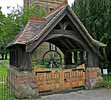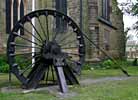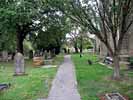Underwood St Michael and All AngelsChurchyard
 The lych gate The lych gate |
The church occupies a large corner site with entrances on the east and north side. Whilst the north entrance is a simple gate, at the main east entrance is an ornate lych gate set just to the south side of the church. It has a pair of low wooden gates with panels filling the lower parts with open slats above. It is hinged on the low stone walls which are built from coursed stone of varying hues from beige, grey and weathered cream. Resting on the walls and continuing into the churchyard is the timber framework of oak uprights carrying the roof structure of equal dimensions. Over the gate is a low arch of timber. All the roof rafters are boarded over on the upper face, with the entire roof tiled with flat red tiles. It is made even more elaborate by the roof formed with two sections, one east-west the other south-north, effectively creating a cruciform plan. A finial rising from the apex of the gable over the east gate completes the design.
 The Pye Hill No. 1 The Pye Hill No. 1
Colliery memorial |
An unusual memorial is set at the east end of the churchyard a short distance from the lych gate. It commemorates the existence of the Pye Hill No. 1 colliery (originally known as the Underwood or Selston Colliery) that provided employment and homes to the community, and was the reason for the development of the village. It takes the form of an original headstock winding wheel from the colliery. It is painted bright blue with the axle painted red, and is complete with a section of winding cable, all supported by steel work similar to that which would have been used for the winding tower. The assembly is set in a cruciform of concrete. A small plaque carries the dedication:
A Memorial to Pye Hill
Number 1 Colliery
Dedicated by
The Bishop of Southwell
The Rt. Reverend R. Darby
On 28th September 1985 |
 The south side of the The south side of the
churchyard looking west |
 CWGC headstone CWGC headstone
to Joseph Castledine
(died 1940) |
The area of the churchyard is very substantial and appears to well used and maintained, with a number of mature trees and paths. At the western end there is an area of ground, as yet unused, allowing many more spaces for burials. It has several interesting grave markers, including two war graves marked with CWGC headstones.
A range of materials has been used to surround the churchyard. At the east end the iron railings between the low but dense hedging, there is a mixture of modern interwoven fence panels and hedging, the north part stone walling and hedging, with the south the same plus some trees.
|